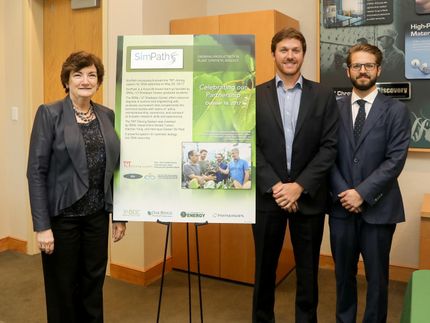Researchers reveal structure of a key enzyme, without which animals die
For the first time, researchers --all Cornell scientists - have characterized the structure of a protein that belongs to certain enzymes that are essential for proper functioning in all life forms, from yeast to humans.
The enzymes, belonging to the so-called Sac family, are involved in cellular signaling and membrane trafficking. Scientists have found that when the gene that expresses Sac enzymes is deleted in animals, the animals die, and mutations of related genes in humans lead to cancers and such neurodegenerative hereditary diseases as Charcot-Marie-Tooth Type 4J (CMT4J) and Lou Gehrig's disease.
Researchers from Cornell's Weill Institute of Cell and Molecular Biology, reporting in the Journal of the European Molecular Biology Organization, have characterized for the first time the crystal structure of the Sac1 protein in yeast. Yeast serves as a model organism for all cells; most of the 6,000 genes in yeast are also found in humans. The Sac1 protein in yeast is a progenitor for related Sac proteins also found in plants and animals.
Understanding the Sac1 protein's structure opens the way for experiments that may reveal how these fundamental enzymes interact with cell membranes to enable essential cellular processes, which could also lead to drugs that target related diseases.
"This enzyme was first discovered in 1989, but no one had seen the atomic structure of this protein," said Yuxin Mao, an assistant professor of molecular biology and genetics and the paper's senior author. Andrew Manford, a graduate student in the lab of Scott Emr, director of the Weill Institute, is the paper's lead author. "Others have tried, but this is the first time" the protein's structure has been revealed, said Mao.
Much like an on and off switch, pathways that signal cells to divide, migrate or transport materials in and out of the cell are often activated by attaching a phosphate group to proteins or lipids (a process called phosphorylation) and similarly deactivated by the removal of the phosphate group. A class of enzymes called phosphatases mediates the removal of phosphates, and the Sac family of enzymes the Cornell researchers studied are lipid phosphatases. Such diseases as CMT4J and Lou Gehrig's disease occur when Sac family phosphatases fail to function properly, leading to a buildup of a group of phosphorylated lipids.
Mao and colleagues determined the structure by growing Sac protein crystals, which allowed researchers to view a protein's atomic structure through X-ray diffraction. Mao's lab used Cornell's synchrotron to solve the crystal structure of the Sac1 protein at an atomic resolution of less than 2 angstroms (two ten-millionths of a millimeter).
"This opens up biochemical studies of how these enzymes function -- it's a breakthrough in this direction of study," said Mao. "And it helps our studies of other members of the Sac family."
Topics
Organizations
Other news from the department science
These products might interest you

Hahnemühle LifeScience Catalogue Industry & Laboratory by Hahnemühle
Wide variety of Filter Papers for all Laboratory and Industrial Applications
Filtration Solutions in the Life Sciences, Chemical and Pharmaceutical Sectors

Hydrosart® Ultrafilter by Sartorius
Efficient ultrafiltration for biotech and pharma
Maximum flow rates and minimum protein loss with Hydrosart® membranes

Hydrosart® Microfilter by Sartorius
Hydrophilic microfilters for bioprocesses
Minimal protein adsorption and high flow rates

Sartobind® Rapid A by Sartorius
Efficient chromatography with disposable membranes
Increase productivity and reduce costs with fast cycle times

Sartopore® Platinum by Sartorius
Efficient filtration with minimal protein adsorption
Reduces rinsing volume by 95 % and offers 1 m² filtration area per 10"

Polyethersulfone Ultrafilter by Sartorius
Reliable filtration with PESU membranes
Perfect for biotechnology and pharmaceuticals, withstands sterilisation and high temperatures

Polyethersulfone Microfilter by Sartorius
Biotechnological filtration made easy
Highly stable 0.1 µm PESU membranes for maximum efficiency

Get the life science industry in your inbox
By submitting this form you agree that LUMITOS AG will send you the newsletter(s) selected above by email. Your data will not be passed on to third parties. Your data will be stored and processed in accordance with our data protection regulations. LUMITOS may contact you by email for the purpose of advertising or market and opinion surveys. You can revoke your consent at any time without giving reasons to LUMITOS AG, Ernst-Augustin-Str. 2, 12489 Berlin, Germany or by e-mail at revoke@lumitos.com with effect for the future. In addition, each email contains a link to unsubscribe from the corresponding newsletter.



















































